

What does really mean Integrated Mental Health Care? Benedetto Saraceno University of Geneva University of Lisbon
Service Organization: Optimal Mix of Services HIGH LOW Mental Hospitals & Specialist Services FREQUENCY OF NEED Community Psychiatric COSTS Mental Services in Health General Services Hospitals Mental Health Services through PHC INFORMAL COMMUNITY CARE SELF CARE LOW HIGH QUANTITY OF SERVICES NEEDED
Optimal mix? 1. Where the needs are there is no care 2. Funding allocation is not matching with needs 3. Location of Care is not matching with needs
The voice of the pyramid: we need care where the needs are 1. Where the needs are there is no care a) absolute lack of coverage b) relative lack of coverage (care exists but is not where the needs are)
Absolute Gap (lack of coverage) The proportion of people with mental disorders receiving treatment is far to be adequate: a) in USA: 32.9% treated, all mental disorders (Kessler,2005) b) In Russia: 25% treated, depression
Treatment Gap • Serious cases receiving no treatment during the last 12 months – Developing countries- 76.3 to 85.4 % – Developed countries- 35.5 to 50.3 % WHO World Mental Health Consortium JAMA, June 2 nd 2004
The treatment gap
Relative Gap (lack of focus) • Many people receive treatment for mental disorders but they do not have mental disorders • In 2003 in the USA only half of the people who received treatment had conditions that met diagnostic criteria (Kessler 2005)!!
The voice of the pyramid: we need care where the needs are 2. Funding allocation is not matching with needs a) Insufficient allocation b) Inefficient allocation
INSUFFICIENCY: Burden/budget gap: too large ! 15% 13% 10% Budget Burden 5% 3% 0%
Mental Health Budget and Total health Budget
INEFFICIENCY Residential Facilities 16% General Hospitals 21% Mental Hospitals 62%
….where are the resources for mental health care? a) in psychiatric hospitals b) in highly specialized units with no catchment area c) in private institutions with or without contract agreement with public sector
The voice of the pyramid: we need care where the needs are 3. Location of Care is not matching with needs a) Too many psychiatric hospitals b) Too many beds in psychiatric hospitals c) Not enough alternative solutions for long stay users d) Not enough beds in General Hospitals e) Not enough Community Mental Health Centers f) Not enough mental health literacy in PHC
CONCLUSION: resources are far from needs • People need more services (more absolute coverage) • With more efficient allocation of resources • (reversing the pyramid) • With more focus (less avoidable treatments) • People need services close to home: PHC and CMHC (real availability)
LANCET SERIES: Global Mental Health Benedetto Saraceno, Mark van Ommeren, Rajaie Batniji, Alex Cohen, Oye Gureje, John Mahoney, Devi Sridhar, Chris Underhill Barriers to improvement of mental health services in low-income and middle-income countries Lancet. 2007 Sep 29; 370(9593):1164-74.
Barrier 1: Mental health resources centralized in and near big cities and in large institutions • Need for extra funding to shift to community-based services • Resistance by mental health professionals and workers, whose interests are served by large hospitals
Psychiatric beds in each WHO Region and the world (ATLAS Data, per 10,000 population)
Total mental health beds in Europe per 100 000 population
Barrier 2: Difficulties in integrating mental health care in primary health care services • Primary care workers already overburdened • Lack of supervision and specialist support after training, • Lack of continuous supply of psychotropics in primary care in many countries
Learning core competencies for PHC • Assessment and diagnosis: simplified but reliable GHQ, ICD 10phc, AUDIT, ASSIST, mhGAP • Listening and Support (key principles) • Treatment (simplified but evidence based) • Referral (to whom? A responsible specialist service) • Community Intervention (community alliances)
Barrier 3: Lack of investment in secondary care: the missing number • 3 • ? • 1
Severe Mental disorders determine disabilities Mental disabilities are chronic conditions and require long-term care
Are Psychiatric Hospital providing adequate long-term care? Too often Psychiatric Hospitals determine 1. accumulation of deficit symptoms 2. social isolation 3. ill-treatment to patients 4. very low cost-effectiveness 5. users’ dissatisfaction
Severe Mental Disabilities: history of a denial • Asylum the « invented city » • Unplanned de-hospitalization • abandonment and family burden • Homelesness the diffuse asylum • Trans Institutionalization « the imbroglio »
But why institutionalization? • a) long term protection • b) long term care and assistance • c) family relief
Mental disabilities are chronic conditions and require long-term care Deinstitutionalization = De-hospitalization + Long-Term Care
Deinstitutionalization is needed ….but Deinstitutionalization is more than De-hospitalization Deinstitutionalization is De-hospitalization + Long-Term Care
Long Term Care= 5 C • Comprehensiveness: broad spectrum of offers (psychiatric care, family support, housing, employment, inclusion strategies) • Community Long Term Care: long term perspective (spectrum from permanent care to full recovery) • Continuity of care : continuity across time and across space: ONE service • Collegiality: multiprofessional team + users & families • Capacity: new skills are needed
Axes of Psychosocial Rehabilitation • Habitat Home House • Learning, Applying Knowledge and Communicating Socialization • Social Value Work Employment
Barrier 4: Mental health leadership often lacks public health skills and experience • Those who rise to leadership positions often only trained in clinical management • Public health training does not include mental health
Barrier 5: Political will (& thus funding) for mental health is low, because of • Inconsistent and unclear advocacy by MH advocates • People with disorders not organized in a powerful lobby in many countries • Incorrect belief that care is cost-ineffective
Pending Issues 1. the balance (resources and weight) between hospital and community care (hospital means general hospital and not psychiatric hospital) 2. community care means comprehensive care and not ambulatory care
Recommend
More recommend